MVC框架 - 高階範例
在第一個MVC教學章中,我們學會了如何在MVC控制器和檢視進行互動。在本教學中,我們將向前更進一步,學習如何使用模型建立高階應用程式來建立,編輯,刪除使用者,在我們的應用程式中檢視列表。
下面是用來建立高階MVC應用程式的步驟
第1步:選擇 File->New->Project->ASP.NET MVC Web應用. 並命名為:AdvancedMVCApplication. 單擊確定。在接下來的視窗中,選擇模板作為網際網路應用程式和檢視引擎為Razor。注意,我們這個時候使用的是模板,而不是一個空的應用程式。
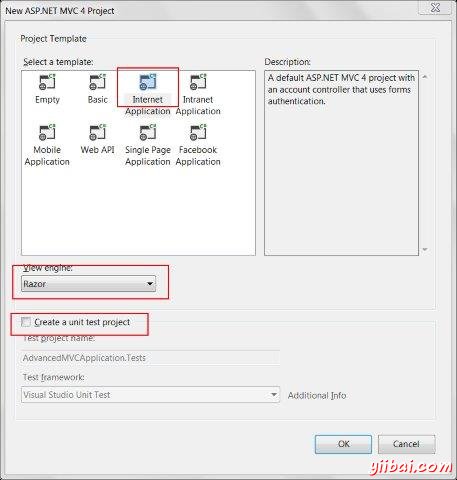
這將建立一個新的解決方案的專案,如下圖所示。由於我們使用的是預設的ASP.NET主題,它帶有樣本檢視,控制器,模型和其他檔案。
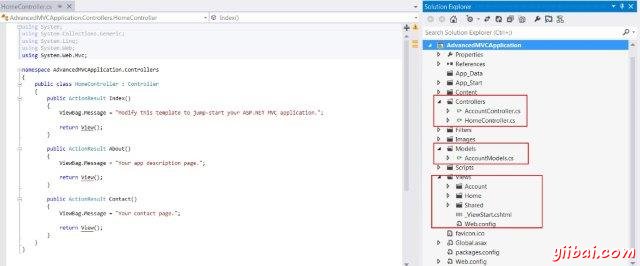
構建解決方案,並執行應用程式,看看它的預設輸出,如下:
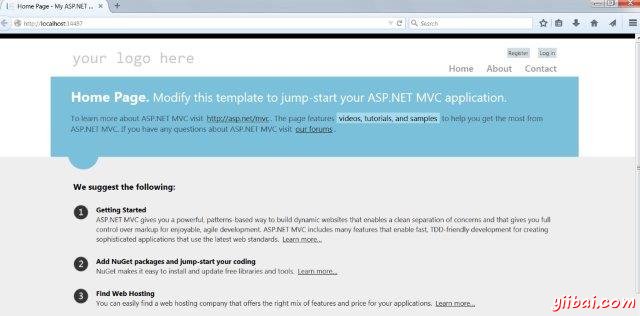
第2步:我們將增加一個新的模式,將定義的使用者資料結構。右鍵單擊Models檔案夾,然後點選 Add->Class. 命名為UserModel,然後單擊Add。
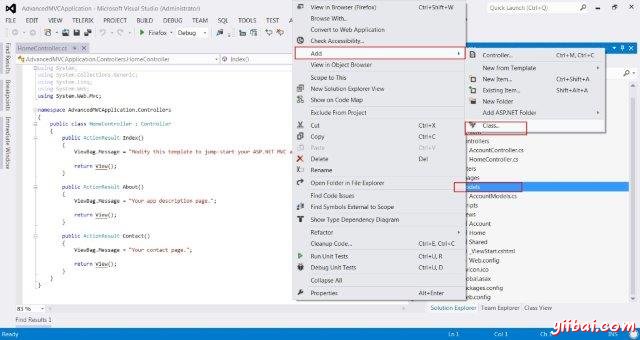
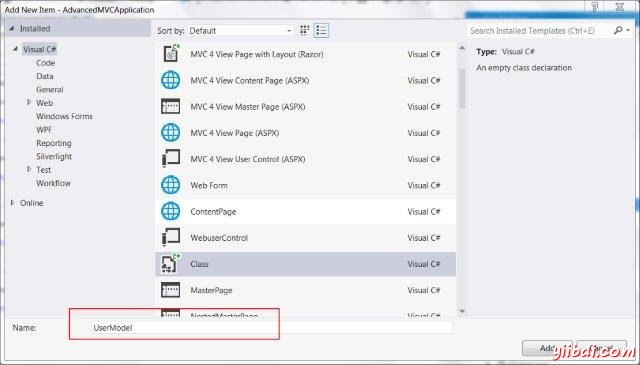
第3步:現在將以下程式碼複製到新建立的UserModel.cs:
using System;
using System.ComponentModel;
using System.ComponentModel.DataAnnotations;
using System.Web.Mvc.Html;
namespace AdvancedMVCApplication.Models
{
public class UserModels
{
[Required]
public int Id { get; set; }
[DisplayName("First Name")]
[Required(ErrorMessage = "First name is required")]
public string FirstName { get; set; }
[Required]
public string LastName { get; set; }
public string Address { get; set; }
[Required]
[StringLength(50)]
public string Email { get; set; }
[DataType(DataType.Date)]
public DateTime DOB { get; set; }
[Range(100,1000000)]
public decimal Salary { get; set; }
}
}
在上面的程式碼中,我們指定的使用者模型驗證所有的引數,其資料型別和如所需的欄位和長度。
第4步:現在,我們有使用者模型準備儲存資料,現在建立一個類檔案Users.cs 其中將包含用於檢視使用者,新增,編輯和刪除使用者的方法。右鍵單擊模型,然後單擊 Add->Class. 命名為:Users. 這將建立users.cs類在Models內部。
複製下面的程式碼到users.cs類。
using System;
using System.Collections.Generic;
using System.EnterpriseServices;
namespace AdvancedMVCApplication.Models
{
public class Users
{
public List UserList = new List();
//action to get user details
public UserModels GetUser(int id)
{
UserModels usrMdl = null;
foreach (UserModels um in UserList)
if (um.Id == id)
usrMdl = um;
return usrMdl;
}
//action to create new user
public void CreateUser(UserModels userModel)
{
UserList.Add(userModel);
}
//action to udpate existing user
public void UpdateUser(UserModels userModel)
{
foreach (UserModels usrlst in UserList)
{
if (usrlst.Id == userModel.Id)
{
usrlst.Address = userModel.Address;
usrlst.DOB = userModel.DOB;
usrlst.Email = userModel.Email;
usrlst.FirstName = userModel.FirstName;
usrlst.LastName = userModel.LastName;
usrlst.Salary = userModel.Salary;
break;
}
}
}
//action to delete exising user
public void DeleteUser(UserModels userModel)
{
foreach (UserModels usrlst in UserList)
{
if (usrlst.Id == userModel.Id)
{
UserList.Remove(usrlst);
break;
}
}
}
}
}
第5步:一旦我們有UserModel.cs和Users.cs,將增加瀏覽模型檢視,新增,編輯和刪除使用者。首先,讓我們建立一個檢視用來建立使用者。右鍵單擊Views檔案夾,然後點選 Add->View.
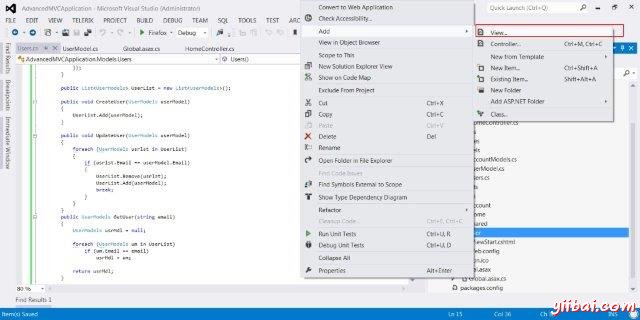
在接下來的視窗中,選擇檢視名稱為UserAdd,檢視引擎為Razor,並選擇建立一個強型別的檢視核取方塊。
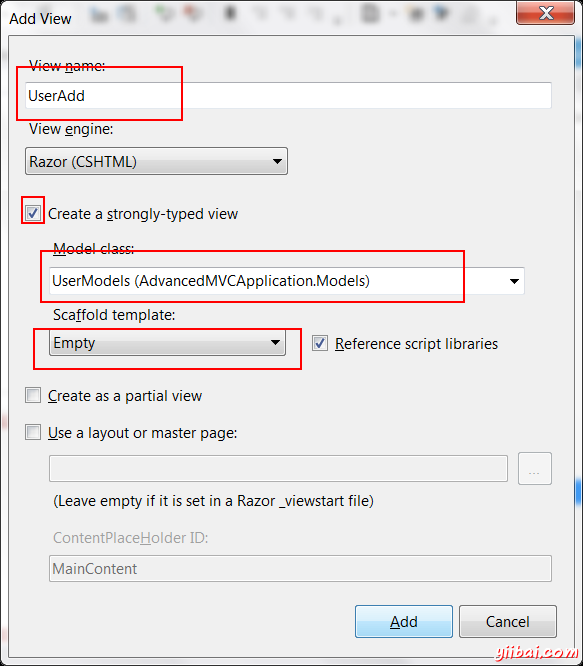
單擊新增。在預設情況下這將建立下列CSHML程式碼,如下所示:
@model AdvancedMVCApplication.Models.UserModels
@{
ViewBag.Title = "UserAdd";
}
<h2>UserAdd</h2>
@using (Html.BeginForm()) {
@Html.ValidationSummary(true)
<fieldset>
<legend>UserModels</legend>
<div class="editor-label">
@Html.LabelFor(model => model.FirstName)
</div>
<div class="editor-field">
@Html.EditorFor(model => model.FirstName)
@Html.ValidationMessageFor(model => model.FirstName)
</div>
<div class="editor-label">
@Html.LabelFor(model => model.LastName)
</div>
<div class="editor-field">
@Html.EditorFor(model => model.LastName)
@Html.ValidationMessageFor(model => model.LastName)
</div>
<div class="editor-label">
@Html.LabelFor(model => model.Address)
</div>
<div class="editor-field">
@Html.EditorFor(model => model.Address)
@Html.ValidationMessageFor(model => model.Address)
</div>
<div class="editor-label">
@Html.LabelFor(model => model.Email)
</div>
<div class="editor-field">
@Html.EditorFor(model => model.Email)
@Html.ValidationMessageFor(model => model.Email)
</div>
<div class="editor-label">
@Html.LabelFor(model => model.DOB)
</div>
<div class="editor-field">
@Html.EditorFor(model => model.DOB)
@Html.ValidationMessageFor(model => model.DOB)
</div>
<div class="editor-label">
@Html.LabelFor(model => model.Salary)
</div>
<div class="editor-field">
@Html.EditorFor(model => model.Salary)
@Html.ValidationMessageFor(model => model.Salary)
</div>
<p>
<input type="submit" value="Create" />
</p>
</fieldset>
}
<div>
@Html.ActionLink("Back to List", "Index")
</div>
@section Scripts {
@Scripts.Render("~/bundles/jqueryval")
}
正如所看到的,這個檢視包含欄位的所有屬性資訊的驗證訊息,標籤等,此檢視在我們最終的應用程式看起來像這樣:
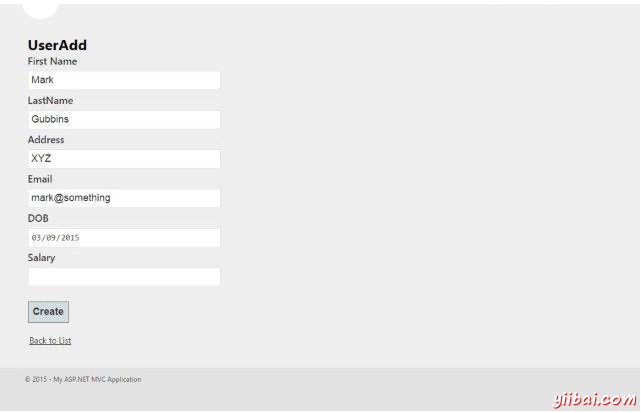
類似UserAdd,,現在我們將增加如下四個檢視程式碼:
Index.cshtml
該檢視將顯示所有存在於我們的系統中的使用者在Index頁面上。
@model IEnumerable<AdvancedMVCApplication.Models.UserModels>
@{
ViewBag.Title = "Index";
}
<h2>Index</h2>
<p>
@Html.ActionLink("Create New", "UserAdd")
</p>
<table>
<tr>
<th>
@Html.DisplayNameFor(model => model.FirstName)
</th>
<th>
@Html.DisplayNameFor(model => model.LastName)
</th>
<th>
@Html.DisplayNameFor(model => model.Address)
</th>
<th>
@Html.DisplayNameFor(model => model.Email)
</th>
<th>
@Html.DisplayNameFor(model => model.DOB)
</th>
<th>
@Html.DisplayNameFor(model => model.Salary)
</th>
<th></th>
</tr>
@foreach (var item in Model) {
<tr>
<td>
@Html.DisplayFor(modelItem => item.FirstName)
</td>
<td>
@Html.DisplayFor(modelItem => item.LastName)
</td>
<td>
@Html.DisplayFor(modelItem => item.Address)
</td>
<td>
@Html.DisplayFor(modelItem => item.Email)
</td>
<td>
@Html.DisplayFor(modelItem => item.DOB)
</td>
<td>
@Html.DisplayFor(modelItem => item.Salary)
</td>
<td>
@Html.ActionLink("Edit", "Edit", new { id=item.Id }) |
@Html.ActionLink("Details", "Details", new { id=item.Id }) |
@Html.ActionLink("Delete", "Delete", new { id=item.Id })
</td>
</tr>
}
</table>
此檢視在我們最終的應用程式看起來如下:

Details.cshtml:
此檢視將顯示特定使用者的詳細資訊,當我們點選使用者記錄。
@model AdvancedMVCApplication.Models.UserModels
@{
ViewBag.Title = "Details";
}
<h2>Details</h2>
<fieldset>
<legend>UserModels</legend>
<div class="display-label">
@Html.DisplayNameFor(model => model.FirstName)
</div>
<div class="display-field">
@Html.DisplayFor(model => model.FirstName)
</div>
<div class="display-label">
@Html.DisplayNameFor(model => model.LastName)
</div>
<div class="display-field">
@Html.DisplayFor(model => model.LastName)
</div>
<div class="display-label">
@Html.DisplayNameFor(model => model.Address)
</div>
<div class="display-field">
@Html.DisplayFor(model => model.Address)
</div>
<div class="display-label">
@Html.DisplayNameFor(model => model.Email)
</div>
<div class="display-field">
@Html.DisplayFor(model => model.Email)
</div>
<div class="display-label">
@Html.DisplayNameFor(model => model.DOB)
</div>
<div class="display-field">
@Html.DisplayFor(model => model.DOB)
</div>
<div class="display-label">
@Html.DisplayNameFor(model => model.Salary)
</div>
<div class="display-field">
@Html.DisplayFor(model => model.Salary)
</div>
</fieldset>
<p>
@Html.ActionLink("Edit", "Edit", new { id=Model.Id }) |
@Html.ActionLink("Back to List", "Index")
</p>
此檢視在我們最終的應用程式看起來像這樣:
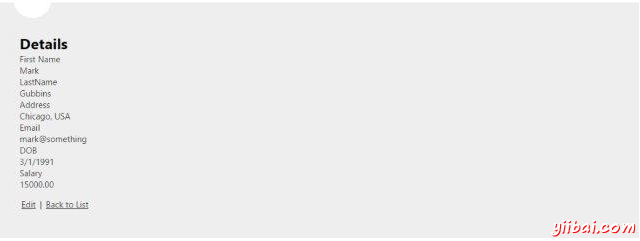
Edit.cshtml:
這檢視將顯示現有使用者的詳細資訊的編輯表單。
@model AdvancedMVCApplication.Models.UserModels
@{
ViewBag.Title = "Edit";
}
<h2>Edit</h2>
@using (Html.BeginForm()) {
@Html.AntiForgeryToken()
@Html.ValidationSummary(true)
<fieldset>
<legend>UserModels</legend>
@Html.HiddenFor(model => model.Id)
<div class="editor-label">
@Html.LabelFor(model => model.FirstName)
</div>
<div class="editor-field">
@Html.EditorFor(model => model.FirstName)
@Html.ValidationMessageFor(model => model.FirstName)
</div>
<div class="editor-label">
@Html.LabelFor(model => model.LastName)
</div>
<div class="editor-field">
@Html.EditorFor(model => model.LastName)
@Html.ValidationMessageFor(model => model.LastName)
</div>
<div class="editor-label">
@Html.LabelFor(model => model.Address)
</div>
<div class="editor-field">
@Html.EditorFor(model => model.Address)
@Html.ValidationMessageFor(model => model.Address)
</div>
<div class="editor-label">
@Html.LabelFor(model => model.Email)
</div>
<div class="editor-field">
@Html.EditorFor(model => model.Email)
@Html.ValidationMessageFor(model => model.Email)
</div>
<div class="editor-label">
@Html.LabelFor(model => model.DOB)
</div>
<div class="editor-field">
@Html.EditorFor(model => model.DOB)
@Html.ValidationMessageFor(model => model.DOB)
</div>
<div class="editor-label">
@Html.LabelFor(model => model.Salary)
</div>
<div class="editor-field">
@Html.EditorFor(model => model.Salary)
@Html.ValidationMessageFor(model => model.Salary)
</div>
<p>
<input type="submit" value="Save" />
</p>
</fieldset>
}
<div>
@Html.ActionLink("Back to List", "Index")
</div>
@section Scripts {
@Scripts.Render("~/bundles/jqueryval")
}
此檢視在我們的應用程式看起來如下:
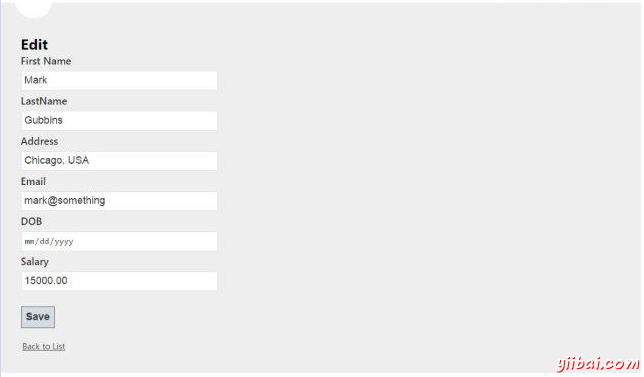
Delete.cshtml:
此檢視將顯示表單用於刪除現有使用者。
@model AdvancedMVCApplication.Models.UserModels
@{
ViewBag.Title = "Delete";
}
<h2>Delete</h2>
<h3>Are you sure you want to delete this?</h3>
<fieldset>
<legend>UserModels</legend>
<div class="display-label">
@Html.DisplayNameFor(model => model.FirstName)
</div>
<div class="display-field">
@Html.DisplayFor(model => model.FirstName)
</div>
<div class="display-label">
@Html.DisplayNameFor(model => model.LastName)
</div>
<div class="display-field">
@Html.DisplayFor(model => model.LastName)
</div>
<div class="display-label">
@Html.DisplayNameFor(model => model.Address)
</div>
<div class="display-field">
@Html.DisplayFor(model => model.Address)
</div>
<div class="display-label">
@Html.DisplayNameFor(model => model.Email)
</div>
<div class="display-field">
@Html.DisplayFor(model => model.Email)
</div>
<div class="display-label">
@Html.DisplayNameFor(model => model.DOB)
</div>
<div class="display-field">
@Html.DisplayFor(model => model.DOB)
</div>
<div class="display-label">
@Html.DisplayNameFor(model => model.Salary)
</div>
<div class="display-field">
@Html.DisplayFor(model => model.Salary)
</div>
</fieldset>
@using (Html.BeginForm()) {
@Html.AntiForgeryToken()
<p>
<input type="submit" value="Delete" /> |
@Html.ActionLink("Back to List", "Index")
</p>
}
此檢視在我們最終的應用程式看起來像這樣:
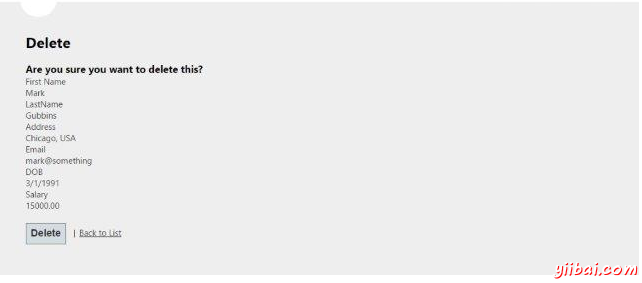
第6步:我們已經增加模型和檢視在應用程式中。現在新增一個控制器,用於檢視。 右鍵單擊Controllers檔案夾,然後點選 Add->Controller. 命名為: UserController.
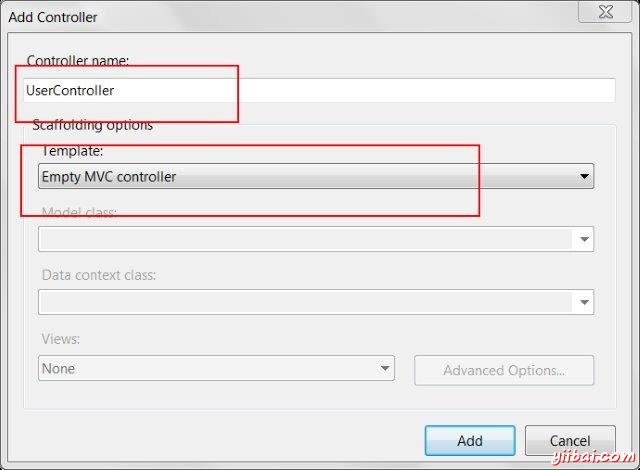
預設情況下,控制器類將用下面的程式碼來建立:
using System;
using System.Collections.Generic;
using System.Linq;
using System.Web;
using System.Web.Mvc;
using AdvancedMVCApplication.Models;
namespace AdvancedMVCApplication.Controllers
{
public class UserController : Controller
{
private static Users _users = new Users();
public ActionResult Index()
{
return View(_users.UserList);
}
}
}
在上面的程式碼中,Index方法將在呈現使用者列表在Index頁面上。
第6步:右鍵單擊Index方法,並選擇建立檢視來建立Index頁面檢視(其中會列出所有使用者,並提供選項來建立新的使用者)。
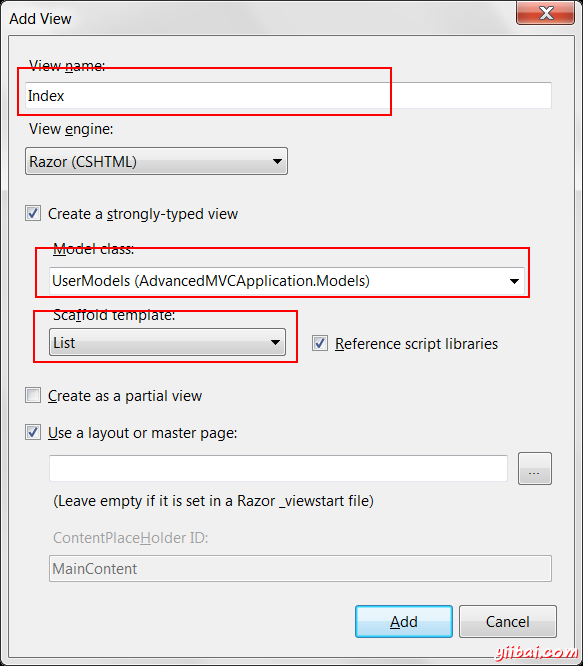
第7步:現在新增以下程式碼UserController.cs。在這段程式碼中,我們建立操作方法針對不同的使用者操作,返回之前建立相應的檢視。
我們將新增兩個方法為每個操作:GET和POST。當獲取資料時,其HttpGet被使用。HttpPost將用於建立/更新資料。例如,當我們要新增新使用者,需要一個表單來新增使用者,這是一個GET操作。當我們填寫表格,並提交這些值,需要使用POST方法。
//Action for Index View
public ActionResult Index()
{
return View(_users.UserList);
}
//Action for UserAdd View
[HttpGet]
public ActionResult UserAdd()
{
return View();
}
[HttpPost]
public ActionResult UserAdd(UserModels userModel)
{
_users.CreateUser(userModel);
return View("Index", _users.UserList);
}
//Action for Details View
[HttpGet]
public ActionResult Details(int id)
{
return View(_users.UserList.FirstOrDefault(x => x.Id == id));
}
[HttpPost]
public ActionResult Details()
{
return View("Index", _users.UserList);
}
//Action for Edit View
[HttpGet]
public ActionResult Edit(int id)
{
return View(_users.UserList.FirstOrDefault(x=>x.Id==id));
}
[HttpPost]
public ActionResult Edit(UserModels userModel)
{
_users.UpdateUser(userModel);
return View("Index", _users.UserList);
}
//Action for Delete View
[HttpGet]
public ActionResult Delete(int id)
{
return View(_users.UserList.FirstOrDefault(x => x.Id == id));
}
[HttpPost]
public ActionResult Delete(UserModels userModel)
{
_users.DeleteUser(userModel);
return View("Index", _users.UserList);
} sers.UserList);
}
第8步:最後要做的就是到App_Start檔案夾找到RouteConfig.cs檔案,並更改預設的控制器。
defaults: new { controller = "User", action = "Index", id = UrlParameter.Optional }
第9步:下面是高階應用範例程式啟動和執行。現在執行應用程式。將能夠看到這樣的應用程式,並可以執行新增,檢視,編輯,刪除使用者,因為在前面的截圖已經看到了所有功能。
